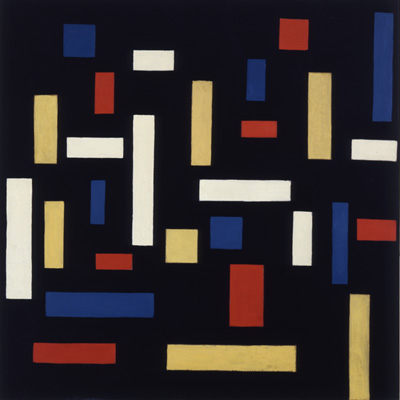 |
This is a file from the Wikimedia Commons. Information from its description page there is shown below.
Commons is a freely licensed media file repository. You can help.
|
| Artist |
Theo van Doesburg (1883, Utrecht – 1931, Davos) |
| Title |
English: Composition VII (The Three Graces).
Nederlands: Compositie VII (de drie gratiën).
Alternate titles:
Nederlands: Vijfde compositie, 1917, motief ‘De drie gratiën’ (1917).
Français : Les trois grâces (1935).
English: Three Graces (1936).
Nederlands: De drie Gratiën (1936).
Français : Composition VII (1945).
English: Composition 7 (1947).
Nederlands: Compositie VII ‘de drie gratieën’ (1968, 1969).
Deutsch: Komposition VII ‘Die drei Grazien’ (1969, 1983).
Français : Composition VII dite Les Trois Grâces (1994).
|
| Date |
English: January-May 1917.
Nederlands: Januari-mei 1917.
|
| Medium |
oil on canvas |
| Dimensions |
85 × 85 cm (33.5 × 33.5 in) |
| Current location |
Mildred Lane Kemper Art Museum. |
| St. Louis, Missouri |
| Notes |
Provenance:
- c. 1921: presented to Lena Milius by Theo van Doesburg
- Date unknown: presented to Nelly van Doesburg by Lena Milius
- 1947: bought by the Washington University Gallery of Art, St. Louis, from Nelly van Doesburg through The Art of this Century Gallery, New York
|
| Source/Photographer |
http://kemperartmuseum.wustl.edu/wu3812.html |
Creator:
Theo van Doesburg (1883–1931)    |
 |
| Alternative names |
Christian Emil Marie (Emile) Küpper, I.K. Bonset |
| Description |
Dutch architect, painter, draughtsman and writer
|
| Date of birth/death |
30 August 1883 |
7 March 1931 |
| Location of birth/death |
Utrecht (city) |
Davos |
| Work period |
1899-1931 |
| Work location |
Amsterdam (1899-1914), Amersfoort (September 1908), Apeldoorn (July 1910), Fort bij Veldhuis ( Heemskerk) (July 1914), Groesbeek (May 1915-June 1915, September 1916), Utrecht (city) (September 1915-1916), Zoeterwoude (1916), Leiden (1916-1921), Paris (28 March 1921), Weimar (1921-1924), Rügen (July 1922-August 1922), Paris (1923), Clamart (1924-1930), Belle-Île-en-Mer (June 1924), Strasbourg (September 1926-February 1928), San Sebastián (1927), Antrain (Summer 1929), The Hague (1929), Auvers-sur-Oise (September 1930), Meudon (December 1930-February 1931), Davos (March 1931) |
| Authority control |
|
Licensing
This is a faithful photographic reproduction of an original two-dimensional work of art. The work of art itself is in the public domain for the following reason:
| Public domainPublic domainfalsefalse |
 |
This work is in the public domain in those countries with a copyright term of life of the author plus 80 years or less.
 You must also include a United States public domain tag to indicate why this work is in the public domain in the United States. Note that Mexico has a term of 100 years and does not implement the rule of the shorter term, so this image may not be in the public domain in Mexico. Côte d'Ivoire has a general copyright term of 99 years, but it does implement the rule of the shorter term. You must also include a United States public domain tag to indicate why this work is in the public domain in the United States. Note that Mexico has a term of 100 years and does not implement the rule of the shorter term, so this image may not be in the public domain in Mexico. Côte d'Ivoire has a general copyright term of 99 years, but it does implement the rule of the shorter term.
català | česky | Deutsch | English | español | suomi | français | עברית | italiano | 日本語 | 한국어 | lietuvių | മലയാളം | македонски | Plattdüütsch | Nederlands | norsk nynorsk | norsk bokmål | polski | português | русский | slovenščina | српски / srpski | svenska | 中文(繁體) | +/−
|
|
This file has been identified as being free of known restrictions under copyright law, including all related and neighboring rights.
|
The official position taken by the Wikimedia Foundation is that "faithful reproductions of two-dimensional public domain works of art are public domain, and that claims to the contrary represent an assault on the very concept of a public domain". For details, see Commons:When to use the PD-Art tag.
This photographic reproduction is therefore also considered to be in the public domain. Please be aware that depending on local laws, re-use of this content may be prohibited or restricted in your jurisdiction. See Commons:Reuse of PD-Art photographs.
|
File usage
The following pages on Schools Wikipedia link to this image (list may be incomplete):
All five editions of Schools Wikipedia were compiled by SOS Children's Villages. SOS Children believes education is an important part of a child's life. That's why we ensure they receive nursery care as well as high-quality primary and secondary education. When they leave school, we support the children in our care as they progress to vocational training or higher education. There are many ways to help with SOS Childrens Villages.




